A Paradise of Islamic Art
The bus winds sharply down a forested driveway, depositing its passengers before a formidable white wall. Like one of famed mythologist Joseph Campbell’s heroes on a journey, they are about to enter the unknown. In a nutshell, Campbell posited that in universal myths the hero’s quest is initiated by entrance into an unfamiliar realm from which he emerges transformed. Never mind that untold dangers await the adventurer – the sole drawback here is that you can’t just settle in for good and that your imagination will be piqued in ways that a quotidian lifestyle can’t satiate.
“Enter therein in peace and tranquility,” reads an inviting Arabic inscription above the doorway, and with that our guide Jean Trapido-Rosenthal ushers the group into Doris Duke’s magnum opus, Shangri La. A chorus of amazed gasps erupt as we step into the foyer. The eyes barely know where to settle first, they’re so bombarded with a magnificent display of color, pattern and light play. Panels fitted with luminous green, blue, yellow and red glass line the upper wall, contrasting against the warm hues of the painted Moroccan ceiling styled out of hand-carved wood. A curving arabesque of flowers and leaves on 17th century Turkish tiles distinguishes one wall, while others feature embroidered 19th century hangings from Uzbekistan. Sun shining through a lattice of wood that offers a glimpse into the courtyard doesn’t detract from the soft glow of several intricately carved metal lamps flanking the doors and suspended from the ceiling. Much of the flooring throughout is coral sandstone, retrieved after the property’s shoreline was blasted to make a port for a yacht.
Each room is more enthralling than the one before, and our knowledgeable escort keeps our attention with tid-bits about Duke’s private life as well as her collection of Islamic art from the far reaches of the globe. The profoundly wealthy heiress was only in her 20s when she staked out her five acres at the foot of Diamond Head in the late 1930s and began honing it into the tantalizing mecca for art and archeology connoisseurs that it is today. The year was 1935 and the land cost a meager $100,000 but it was the most expensive plot in Hawaii at the time. Her home cost $1.4 million to build. And the art inside is priceless.
A guide on a former visit, Gay Sevier, noted that Duke’s little niche of paradise once housed a dozen dogs, an aviary with exotic birds, some of which learned to call out tennis scores, being that the courts were in close proximity. She also had monkeys that were placed in the zoo when she died, but that mysteriously had managed to return to their home by the next morning. Duke herself was a designer, collector, avid swimmer, world traveler and a very private person. She kept her inner chambers mostly off limits to guests, entertaining them instead in her Playhouse, a smaller structure adjacent to the expansive pool. Duke was enormously hands-on in the creation of her wonderland, at one point importing dirtied wall panels that she laboriously worked at with Q-tips, exposing lovely, soft shades of purple, green, blue and gold in what is now her Turkish Room.
The lavishness of the sliding glass walls, India-inspired gardens, the cascading fountains, a 300-pound Indian-French chandelier, and the utter detail and otherworldliness of the visit leaves you tripping on rainbows as you descend back to earth. The hero of the journey, for at least that moment, returns enlightened. And it’s that much harder to go about your common day after being inundated by so much splendor.
the TICKET stub
SHANGRI LA
When: Wednesday-Saturday at 8:30 a.m., 11 a.m. and 1:30 p.m. (call for new hours to begin May 2)
Where: Tours of Shangri La originate at the Honolulu Museum of Art at 900 S. Beretania St.
Cost: $25, $20 for kamaaina
More Info: 532-3685






